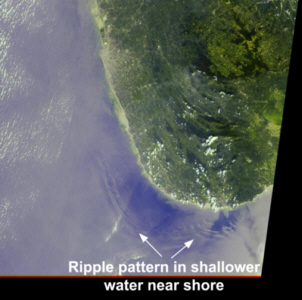by Patrick L. Barry
When JPL research scientist Michael Garay
first heard the news that a tsunami had struck southern Asia, he felt the same
shock and sadness over the tremendous loss of human life that most people certainly
felt. Later, though, he began to wonder: were these waves big enough to see from
space?
So he decided to check. At JPL, Garay analyzes data from MISR—the Multi-angle
Imaging SpectroRadiometer instrument aboard NASA's Terra satellite. He scoured MISR
images from the day of the tsunami, looking for signs of the waves near the coasts
of India, Sri Lanka, Indonesia, and Thailand.
Looking at an image of the southern tip
of Sri Lanka taken by one of MISR's angled cameras, he spotted the distinct shape
of waves made visible by the glint of reflected sunlight. They look a bit like normal waves,
except for their scale: These waves were more than a kilometer wide!
Most satellites have
cameras that point straight down. From that angle, waves are hard to see. But MISR
is unique in having nine cameras, each viewing Earth at a different angle.
"We could see the waves because MISR's forward-looking camera caught the reflected
sunlight just right," Garay explains.
In another set of images, MISR’s cameras
caught the white foam of tsunami waves breaking off the coast of India. By looking
at various angles as the Terra satellite passed over the area, MISR’s cameras snapped
seven shots of the breaking waves, each about a minute apart. This gave scientists a
unique time-lapse view of the motion of the waves, providing valuable data such as the
location, speed, and direction of the breaking waves.
Realizing the importance of the
find, Garay contacted Vasily Titov at the National Oceanic and Atmospheric Administration’s
Pacific Marine Environmental Laboratory in Seattle, Washington. Titov is a tsunami
expert who had made a computer simulation of the Asian tsunami.
"Because the Indian
Ocean doesn't have a tsunami warning system, hardly any scientific measurements of the
tsunami's propagation exist, making it hard for Dr. Titov to check his simulations
against reality," Garay explains. "Our images provide some important data
points to help make his simulations more accurate. By predicting where a tsunami
will hit hardest, those simulations may someday help authorities issue more effective
warnings next time a tsunami strikes."
Find out more about MISR and see the latest images at
www-misr.jpl.nasa.gov/.
Kids can read their own version of the MISR tsunami story at
All content is the responsibility of LUNAR.
If you have comments or suggestions regarding these web pages,
please contact the 


